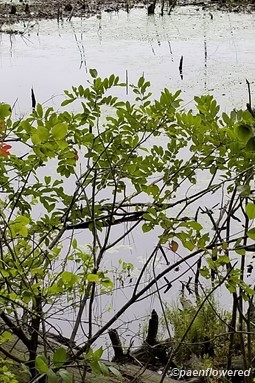Toxicodendron vernix
Toxicodendron vernix poison sumac
Add to MyPlants View Locations
Poison sumac, a.k.a. swamp sumac (Toxicodendron vernix, syn. Rhus vernix), like poison ivy and all of their relatives, belongs to the cashew family (Anacardiaceae). Beware - like poison ivy, the entire plant contains a resin called urushiol that can cause an itchy skin rash (contact dermatitis) on sensitive people. It's more toxic than poison ivy and poison oak due to differences in the chemical structure of the urushiol. Inhaling smoke from burning poison sumac can cause life-threatening pulmonary edema.
My first encounter with poison sumac many years ago was fortunate in the sense that I had a long macro lens and never touched the plant. It was growing in a boggy wetland ringing a natural post-glacial kettle-lake where I couldn't reach it. It wasn't until I got the slides back and tried to identify the plant that I realized my "luck."
The leaves are alternate on the branches and each is compound with 3-6 pairs of opposite leaflets plus one stalked terminal leaflet. The oval leaflets are smooth-edged (entire) and abruptly-pointed at the tips and taper to short stalks at the base. The leaves often form arching, umbrella-like clusters by crowding at the branch ends.
Clusters of small, yellow-green flowers rise in loose panicles from the leaf axils (where the leaves emerge from the branch) in early summer. The flowers turn into whitish, beadlike fruits, each with a single seed much like a cherry or olive (both of which are totally unrelated and safe to eat). The weight of the berries makes each cluster droop. Like other sumacs and poison ivy, the seeds are spread by birds which are immune to the effects of ingesting the berries.
The scientific name, Toxicodendron vernix, translates to "toxic-tree varnish."
Other, non-toxic species of sumacs grow in drier, upland habitats.
Habitat & Range
Occasional in bogs, marshes & fens.
Found throughout the state.
| EMP: | OBL |
|---|---|
| NCNE: | OBL |
Phenology
Flowers in June.
Fruits in August to November.
Plant Codes
S-rank: S4 (Apparently Secure)
G-rank: G5 (Secure)
Ecology
Berries are a food source for various songbirds.
Toxicodendron vernix poison sumac
Synonyms: Rhus vernixAdd to MyPlants View Locations


.JPG?v=638549564730000000)
.JPG?v=638549564730000000)






Comments
Have you spotted this plant in your area? We'd love to hear about your experience! Share your comments or questions about the plant below. Comments are moderated before posting.